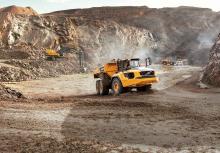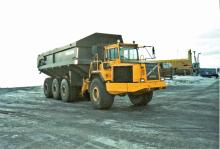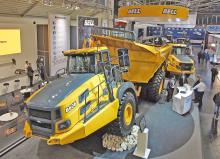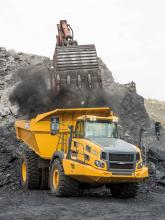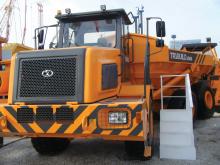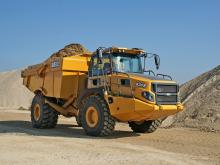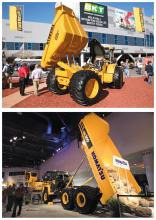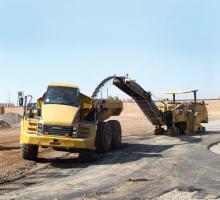Articulated dump trucks offers a versatile solution for earthmoving needs, Mike Woof reports.
The articulated dump truck is now used worldwide in a huge array of earthmoving applications. The market for these versatile machines was developed largely in Northern Europe at first, before spreading to other areas of the world and ADTs can now be regarded as pieces of equipment with global appeal for earthmoving and extraction applications.
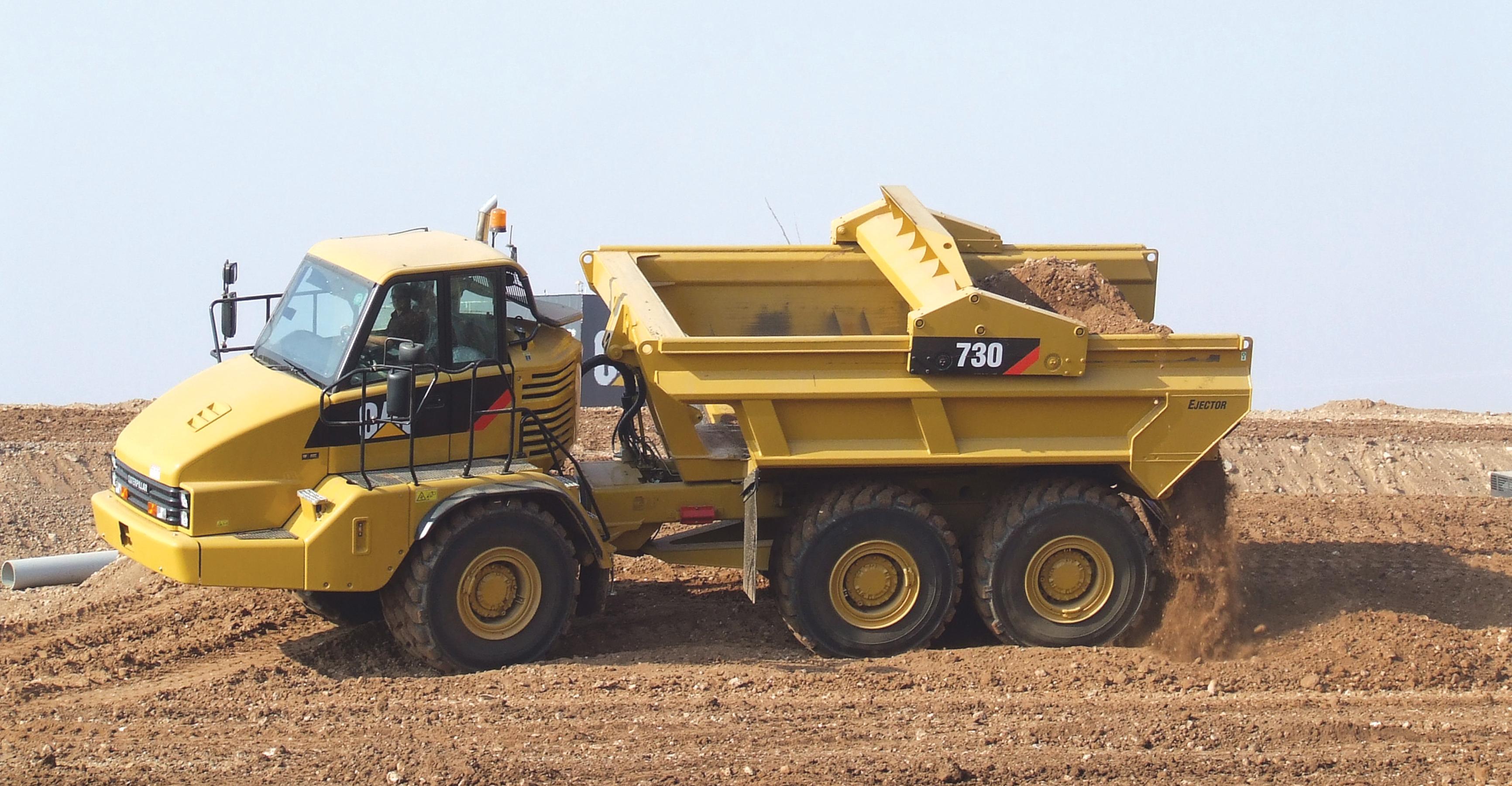
Caterpillar's novel discharge ADT uses scraper ejection technology and is able to dump on the move or on a slope
Articulated dump trucks offers a versatile solution for earthmoving needs, Mike Woof reports The articulated dump truck is now used worldwide in a huge array of earthmoving applications. The market for these versatile machines was developed largely in Northern Europe at first, before spreading to other areas of the world and ADTs can now be regarded as pieces of equipment with global appeal for earthmoving and extraction applications.
The market for ADTs developed because the machines are so versatile. Having all-wheel-drive allows them to cope with soft underfoot conditions and steep ramp hauls where rigid chassis, rear-wheel-drive trucks lose traction. And ADTs are also cheaper to buy than rigid trucks, although the latter tend to have a longer service life. While scrapers still offer high efficiency for moving dirt for short distances, they are less versatile and do not suit longer hauls, reducing their capabilities for utilisation. Many contractors switched from using rigid trucks or scrapers to buying ADTs, because these all-wheel-drive machines offer greater adaptability and utilisation, even though in some specific duties their actual efficiency may not be so high.
There have been some disagreements as to which firm was the first to develop an ADT but it is fair to say that Volvo has a strong claim, having assembled a prototype in 1959 that used a tractor as the power unit. Volvo was also a pioneer in the market with a twin axle, all-wheel-drive production machine, the DR631, in the early 1960s. Volvo's DR860 model appeared in the late 1960s and set the trend for the three axle ADT, although this machine featured a 6x4 configuration with drive to four wheels instead of all six. Because of its early entry to the market,2394 Volvo has dominated the ADT sector for many years, although other leading firms have since developed considerable market share.
Other key firms that set trends in the ADT sector early on include178 Caterpillar (in the UK) and 1239 Moxy (in Norway). For Caterpillar, its entry to the ADT market came indirectly when UK entrepreneur David Brown saw the potential for a twin axle, all-wheel-drive hauler and developed his own machine, using 2294 CAT components as building blocks and marketing the products under the DJB brand. Initially Caterpillar was less than enthused and saw these machines as potential rivals for its own scraper line, but after a series of talks, an agreement was reached.
DJB supplied machines to Caterpillar under a licence agreement for some years, with Caterpillar later buying the manufacturing plant and the rights to the designs outright. The first DJB ADTs were twin axle machines but a line of three axle trucks were then developed, with the 4WD haulers eventually being dropped from the range in favour of the 6WD models. Moxy was the first firm to offer an ADT with a true six-wheel-drive system rather than the 4WD or 6x4 layouts offered by other firms at the time. Although the Moxy design featured two axles, gear driven rear wheels (akin to these used on some graders) ensured that the trucks had 6WD.
Other names came and went from the market while Volvo, DJB/Caterpillar and Moxy built their market shares and these manufacturers were joined in the early 1980s by South African company1240 Bell and the UK firm 1222 Terex.
The ADT market continues to evolve and in recent years, other manufacturers have entered the fray. Brazilian company1241 Randon developed ADT models, although these are largely marketed in Latin America. After cutting its supply deal with Moxy for some markets, 2300 Komatsu introduced its own machines and now offers trucks with payloads up to 36tonnes. 255 JCB also has some ADTs in its range, although these are smaller trucks and the company has not yet developed larger machines to compete directly with the mass market units.
The1243 Fiat Group bought the UK-designed DTT line-up and switched production to its Astra rigid dump truck facility in Italy, further developing the range and selling the models under the Astra, Case and Link-Belt brands in different markets. Korean firm 695 Doosan is another newcomer to the ADT market, following its recent purchase of the well-established Moxy business. In China, 1246 Beijing Zhonghuan Kinetics (BZK) now has the rights to the UK-designed Aveling Barford RXD25 and RXD28 ADTs.
However, the BZK/Aveling Barford machine are older models and are being sold in developing countries only as they will not be compliant with European or US noise, emission and vibration regulations without significant investment. And after a long development programme, the718 Liebherr ADT is now being launched at 688 Bauma. Technical details of the machine are not available at present although it appears that the machine will now feature a conventional mechanical driveline and six wheel drive. Liebherr's new production machine does not resemble the pre-prototype unit spotted under test on a number of German construction sites in recent years and is a completely new design.
Payload capacity has been a key limiting factor with regard to the ADT sector. The 23, 27, 32 and 36tonne payload classes have become the best accepted sizes of ADTs. While the 23tonne class has been the most popular in the past, there has been a noticeable shift in demand for the larger 36tonne capacity ADTs. There is some interest in the market for larger ADTs too.
There have been 50tonne capacity machines in the past but these had their shortcomings, most notably with a lack of a suitable engine to provide an effective power to weight ratio. The UK-built DJB550 was put into series production but there was not an engine available at the time that was compact enough to fit into the chassis while giving this truck the power it required. The 336kW engine used to power the 550 was sufficient for a smaller class of machine but did not provide the power to weight ratio required to allow the machine similar cycle times as smaller ADTs of the period. There were also service issues over its driveline and after some time in production, the model was dropped from the firm's line-up. It is of note that a small consignment of the 550 models were supplied to a Russian customer and that the Russian firm1247 MoAZ subsequently introduced an ADT that bore an external resemblance to the DJB550. The MoAZ 7503 machine featured a side-mounted cab as well as a body design that was not unlike that seen on the DJB550. However the front chassis of the 7503 was different as could be seen by the dissimilar front axle location while the MoAZ truck also solved the power issue as it was powered by a YaMZ engine rated at a healthy 441kW.
The US firm1248 Wagner, which had pioneered all-wheel-drive on underground haulers with articulating chassis, also entered the ADT sector with its large machine in the early 1990s. The firm unveiled its Fullback prototype as the 645 and then introduced the production model as the 650, with a 45tonne payload. Power for this truck came from a Detroit Diesel Series 60 engine, but like the DJB550 before it the Fullback did not have a suitable power-to-weight ratio. A number of machines were built and these were used on various sites in North America but like the DJB550, these proved to be underpowered and production of the Fullback 650 was halted.
Top of the ADT market in terms of payload remains Volvo's specially-built A70 model. A small number of these machines were built to meet the needs of a Norwegian firm with a specific requirement for an all-wheel-drive truck that would work in a touch operating environment. Because these machines were to carry the full load on a downhill run and return uphill unladen, the normal concerns over power-to-weight ratio in a conventional machine could be overlooked. As a result, the A70 model featured the front chassis and power unit of Volvo's successful A40 truck of the time, while featuring a specially-developed extended rear chassis and dumpbody. To allow the A70 its 65tonne payload without overstressing the axles, the truck featured three axles at the rear instead of the twin axles used on most ADTs with payloads of 36tonnes or more.
Advances in engine technology now provide the power density required to increase ADT payload above the standard 36tonnes. Bell and Moxy have now proven that larger ADTs can be built that offer power-to-weight ratios and uptime to compare with smaller machines. Bell has been offering its 45tonne payload B50 model for some years now and has amassed a number of sales while more recently Moxy developed its 46tonne capacity MT51. These trucks both feature new generation diesels that allow power-to-weight ratios on a par with the 36tonne class ADTs.
The basic ADT concept has also given rise to other machines. These include 4WD tractor units designed for a range of heavy-duty purposes such as towing scraper boxes, fuel bowsers and service trailers as well as trucks with a flat-bed rear and a loading crane. Versions with discharge bodies have also been developed, which offer benefits for unloading on uneven terrain as well as spreading the load. Whether further innovations will spring from the ADT concept remains to be seen.
The market for ADTs developed because the machines are so versatile. Having all-wheel-drive allows them to cope with soft underfoot conditions and steep ramp hauls where rigid chassis, rear-wheel-drive trucks lose traction. And ADTs are also cheaper to buy than rigid trucks, although the latter tend to have a longer service life. While scrapers still offer high efficiency for moving dirt for short distances, they are less versatile and do not suit longer hauls, reducing their capabilities for utilisation. Many contractors switched from using rigid trucks or scrapers to buying ADTs, because these all-wheel-drive machines offer greater adaptability and utilisation, even though in some specific duties their actual efficiency may not be so high.
There have been some disagreements as to which firm was the first to develop an ADT but it is fair to say that Volvo has a strong claim, having assembled a prototype in 1959 that used a tractor as the power unit. Volvo was also a pioneer in the market with a twin axle, all-wheel-drive production machine, the DR631, in the early 1960s. Volvo's DR860 model appeared in the late 1960s and set the trend for the three axle ADT, although this machine featured a 6x4 configuration with drive to four wheels instead of all six. Because of its early entry to the market,
Other key firms that set trends in the ADT sector early on include
DJB supplied machines to Caterpillar under a licence agreement for some years, with Caterpillar later buying the manufacturing plant and the rights to the designs outright. The first DJB ADTs were twin axle machines but a line of three axle trucks were then developed, with the 4WD haulers eventually being dropped from the range in favour of the 6WD models. Moxy was the first firm to offer an ADT with a true six-wheel-drive system rather than the 4WD or 6x4 layouts offered by other firms at the time. Although the Moxy design featured two axles, gear driven rear wheels (akin to these used on some graders) ensured that the trucks had 6WD.
Other names came and went from the market while Volvo, DJB/Caterpillar and Moxy built their market shares and these manufacturers were joined in the early 1980s by South African company
The ADT market continues to evolve and in recent years, other manufacturers have entered the fray. Brazilian company
The
However, the BZK/Aveling Barford machine are older models and are being sold in developing countries only as they will not be compliant with European or US noise, emission and vibration regulations without significant investment. And after a long development programme, the
Payload capacity has been a key limiting factor with regard to the ADT sector. The 23, 27, 32 and 36tonne payload classes have become the best accepted sizes of ADTs. While the 23tonne class has been the most popular in the past, there has been a noticeable shift in demand for the larger 36tonne capacity ADTs. There is some interest in the market for larger ADTs too.
There have been 50tonne capacity machines in the past but these had their shortcomings, most notably with a lack of a suitable engine to provide an effective power to weight ratio. The UK-built DJB550 was put into series production but there was not an engine available at the time that was compact enough to fit into the chassis while giving this truck the power it required. The 336kW engine used to power the 550 was sufficient for a smaller class of machine but did not provide the power to weight ratio required to allow the machine similar cycle times as smaller ADTs of the period. There were also service issues over its driveline and after some time in production, the model was dropped from the firm's line-up. It is of note that a small consignment of the 550 models were supplied to a Russian customer and that the Russian firm
The US firm
Top of the ADT market in terms of payload remains Volvo's specially-built A70 model. A small number of these machines were built to meet the needs of a Norwegian firm with a specific requirement for an all-wheel-drive truck that would work in a touch operating environment. Because these machines were to carry the full load on a downhill run and return uphill unladen, the normal concerns over power-to-weight ratio in a conventional machine could be overlooked. As a result, the A70 model featured the front chassis and power unit of Volvo's successful A40 truck of the time, while featuring a specially-developed extended rear chassis and dumpbody. To allow the A70 its 65tonne payload without overstressing the axles, the truck featured three axles at the rear instead of the twin axles used on most ADTs with payloads of 36tonnes or more.
Advances in engine technology now provide the power density required to increase ADT payload above the standard 36tonnes. Bell and Moxy have now proven that larger ADTs can be built that offer power-to-weight ratios and uptime to compare with smaller machines. Bell has been offering its 45tonne payload B50 model for some years now and has amassed a number of sales while more recently Moxy developed its 46tonne capacity MT51. These trucks both feature new generation diesels that allow power-to-weight ratios on a par with the 36tonne class ADTs.
The basic ADT concept has also given rise to other machines. These include 4WD tractor units designed for a range of heavy-duty purposes such as towing scraper boxes, fuel bowsers and service trailers as well as trucks with a flat-bed rear and a loading crane. Versions with discharge bodies have also been developed, which offer benefits for unloading on uneven terrain as well as spreading the load. Whether further innovations will spring from the ADT concept remains to be seen.

